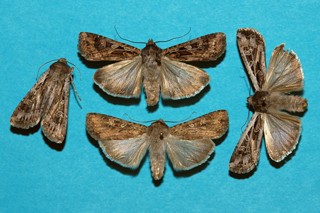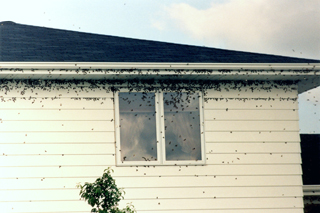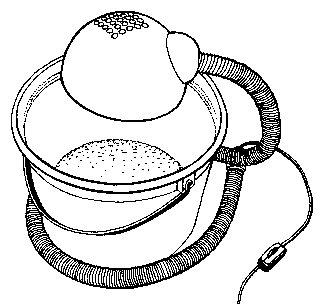G2164
Spring Millers
Spring millers, or adult army cutworms, are prevalent in the spring and fall. Although often a nuisance, these moths are harmless. Management suggestions are provided.
Ronald C. Seymour, Extension Educator
Gary L. Hein, Extension Entomologist
|
Millers can be abundant in and around homes each year, especially in May and early June. At this time of year, the moths are most likely the adult stage of the army cutworm, a common pest of wheat and alfalfa. When abundant, these moths may be very annoying because of their activity and their habit of invading homes, garages, and vehicles. They may cause agitation when great clouds of moths suddenly disperse from landscape bushes, shrubs, doors, and windows when disturbed. Although the moths can be dispersed statewide, the potential for large moth aggregations increases the further west you go in Nebraska. They cause little harm and are present in large numbers for only a few weeks.
Biology
Young larvae of army cutworm moths, or spring millers, feed aboveground in the fall on the leaves of vegetation. They rest throughout the winter and resume feeding in early spring, completing their larval life cycle in late April and May. These insects get their name from their behavior of moving from fields when they are abundant, like an army, in search of better forage. Occasionally people may notice large numbers of these caterpillars moving across roads or sidewalks, as they move from one area to another in search of food.
When high populations of army cutworms are found in wheat and alfalfa fields in the region, expect a large emergence of millers. Army cutworm moths or millers begin to appear in early to late May. The moths are generally gray or light brown (Figure 1), with a wingspan of 1 ½ to 2 inches, each forewing being marked with spots, wavy lines and other dark and light markings. The moths prefer to feed at night on the nectar of flowering shrubs and trees. This feeding does not harm the plants. As dawn approaches, the millers congregate and may enter homes, garages, barns, and sheds in search of resting sites (Figure 2). Narrow cracks or crevices are preferred for these sites, but any protected area is suitable. If the moths are disturbed during the day, they will quickly escape and find new hiding places. At dusk, the moths re-emerge and continue feeding on nectar or migrate to other areas. Some moths, however, may enter homes where they become a nuisance. With the exception of occasionally staining curtains and other surfaces with their droppings, they cause little harm.
Migration
The large numbers of millers noticed in the spring are a result of the migratory nature of these animals. The severity of moth aggregation during the migration will depend on spring cutworm populations and environmental conditions. Moths emerging in Nebraska tend to remain in the area for two to three weeks but may stay for up to six weeks or as long as local plants are flowering. Cool and wet conditions during this time will extend their stay. Hot and dry conditions will encourage the moths to move westward. The moths migrate westward and upward in elevation as they follow the blossoming of spring flowering plants. During this time, with the aid of easterly winds, moth concentrations can increase dramatically. When the last trees finish flowering (e.g., locusts and lindens) and average temperatures increase in the high plains area, the moths move to higher elevations of the Rocky Mountains.
This movement allows the moths to escape severe summer temperatures and to find alpine flowers which are their primary food source. These moths are also an important food source for bears in the mountains. When the alpine summer comes to a close in September, the moths once again take flight, returning to the plains. Army cutworm moths are noticed throughout Nebraska from mid-September through October. As they migrate eastward, the moths mate and lay eggs in barren or sparsely vegetated fields, especially winter wheat, alfalfa, and grasslands. The eggs hatch within a few weeks and the larvae begin to feed.
|
Management
When millers emerge and begin to move westward in the spring, area residents have little recourse but to patiently await their departure. There are a few tactics, however, that can help lessen moth activity in and around homes:
- Keep outside lighting to a minimum. These night-flying moths are attracted to lights. A porch light, inadvertently left on, can attract hundreds or even thousands of these pests.
- Where lighting is necessary, use yellow light bulbs. Yellow light will not attract as many moths because insects do not sense this color very well.
- Seal cracks and crevices with caulking. Place weather stripping around doors and windows. Repair all screens in windows, doors, attic vents, etc.
- Consider using a landscape that minimizes flowering plants and dense vegetation near houses.
If millers enter a house or other buildings, they can be swatted, vacuumed or trapped. A simple trap can be made by placing a light bulb over a shallow pan of soapy water (Figure 3). Once in the trap, the moths cannot escape and can easily be disposed of in the trash. Moths that remain inside a home may stain walls and articles with their droppings. The droppings are generally not difficult to remove. Stains on curtains or clothing can be removed by laundering. Stains on walls, furniture, and other sur- faces may be removed with mild household cleaners.
There is no need to use an insecticide to control these invaders. An insecticide application will have limited effectiveness. It will kill only those that come into contact with it, and more are likely to arrive to take their place. The best solution is to simply keep doors and windows closed, keep porch lights off, and patiently wait for these annoying migrants to move on.
Acknowledgment
Figure 3 is by Jim Kalisch, UNL Department of Entomology.
This publication has been peer reviewed.
Visit the University of Nebraska–Lincoln Extension Publications website for more publications.
Index: Insects & Pests
Other Pests
Issued May 2012


